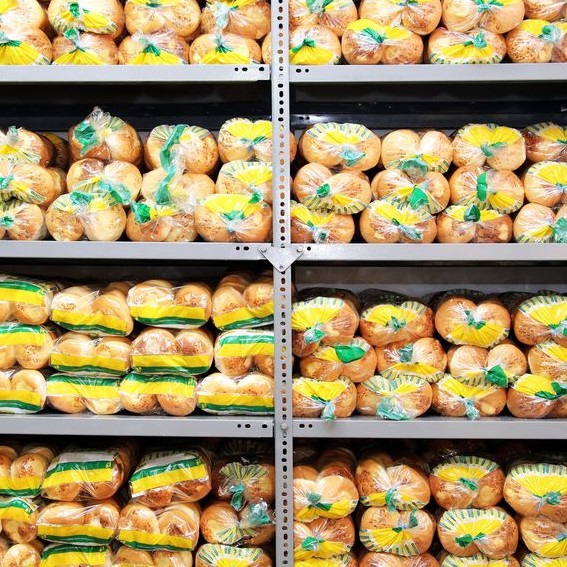
Packaging Materials
What are Packaging Materials?
Packaging materials are essential components of the food supply chain. They are available for virtually any type of product and application, including:
- Finished products
- Raw materials
- Additives
- Specialty ingredients
Packaging materials perform many roles. The most important are:1
- Product protection, containment and preservation of its shelf life
- Customer convenience
- Communication tool (marketing and nutrition labeling)
- Logistics tool for transport and handling
- Traceability mechanism
How Does it Work?
There are three types of packaging materials: primary, secondary and tertiary packaging.
- Primary packaging: materials in direct contact with the product (e.g. plastic bags)
- Secondary packaging: contains primary packaging (e.g corrugated boxes, paperboard)
- Tertiary packaging: contains secondary packaging (e.g shipping containers, baskets, pallets)
Packaging material in wholesale bakeries
Immediately after baking, bread quality starts to show signs of deterioration including loss of flavor and moisture, staling and other undesirable textural changes in the crust and crumb parts. In large-scale bakeries, maintaining safe supply of raw materials and finished products, requires handling thousands of pounds of packaging material per year.
Minor and micro ingredients, such as dough conditioners, mold inhibitors, starches are usually received at the plant in discrete amounts of 2, 5, 10 and 20 pound packs/sacks, given their relatively small quantities. Macro ingredients (e.g. flour, water, sugar and cream yeast) are usually handled in bulk and require only minimum packaging.
A major portion of the total packaging material consumption in bakeries goes to bread bags. Packaging bread in low density polyethylene plastic (LDPE) bags is an almost universal practice. There are 2 types of closures and automatic equipment systems for bread bagging: wire twist-tie and plastic-clip closure.2
Application
Specifications for packaging material should include
- Composition (e.g. polyethylene, polypropylene, metal, paperboard)
- Film thickness
- Amount of protective and barrier layers within film
- Barrier properties (oxygen, water vapor and solutes permeability)
- Mechanical properties (e.g. tensile strength, wear and mechanical stress tolerance)
- Chemical affinity with product components (e.g. fats, flavors and aromas)
- Migration limits of plastic constituents and inks
- Thermal sealability (sideweld seal)
- Stackability in pallet storage
- Hygienic conditions and microbiological load
- Heavy metals content
- Stability to very high and very low temperatures (e.g. frozen dough)
- Friction coefficient
Considerations for the selection of packaging materials
Critical aspects when choosing packaging materials include:
- Product form to be contained (liquid, gas, solid)
- Expected shelf-life of product
- Factors affecting product shelf-life (water activity, acidity, pH, macronutrients, oxygen-, light- and temperature- sensitive micronutrients, susceptibility to oxidative rancidity)
- Biological nature of the packaged product. Enzymes and microorganisms, e.g. yeast and lactic acid bacteria require the highest degree of protection and isolation.
- Reactivity of product (e.g. chemical leaveners, enzymes, redox agents)
- Possibility to support modified atmospheres
Strategies for the reduction of packaging material waste
The environmental burden that plastic packaging waste causes is huge. Global efforts are being made to reduce plastic waste and the food supply chain footprint. Strategies to mitigate negative consequences of packaging materials include:
- Use bulk handling of ingredients
- Optimize multilayered composite package
- Recycle used/opened Kraft paper bags
- Use reverse logistics (effective communication among members of the baking supply chain)
Food safety issues related to packaging materials
Product contamination due to presence of foreign objects related to packaging bags could be a recurrent situation if not properly addressed and controlled with pre-requisite programs and plant workers commitment to food safety.
Areas with the highest risk of product contamination with plastic packaging materials include flour bins, scaling equipment, mixers and open conveying equipment (dough pumps and belt dough conveyors).
Improper disposal of packaging material from ingredients and additives could increase the risk for cross-contamination.
Storage and usage considerations
Packaging material should be kept at an ambient temperature. In case handled in boxes, one box of each bag is all that should be kept in the wrapping room. Products of low volume and/or infrequent runs may have only a wicket of bags in the wrapping room at a time.
References
- Robertson, G.L. “Introduction to Food Packaging.” Food Packaging: Principles and Practice, 3rd edition, CRC Press, Taylor and Francis Group, LLC, 2013, pp. 1–14.
- Good, G.E. “Closures, Bread Bag.” The Wiley Encyclopedia of Packaging Technology, 3rd edition, John Wiley & Sons, Inc., 2009, pp. 284–285.

